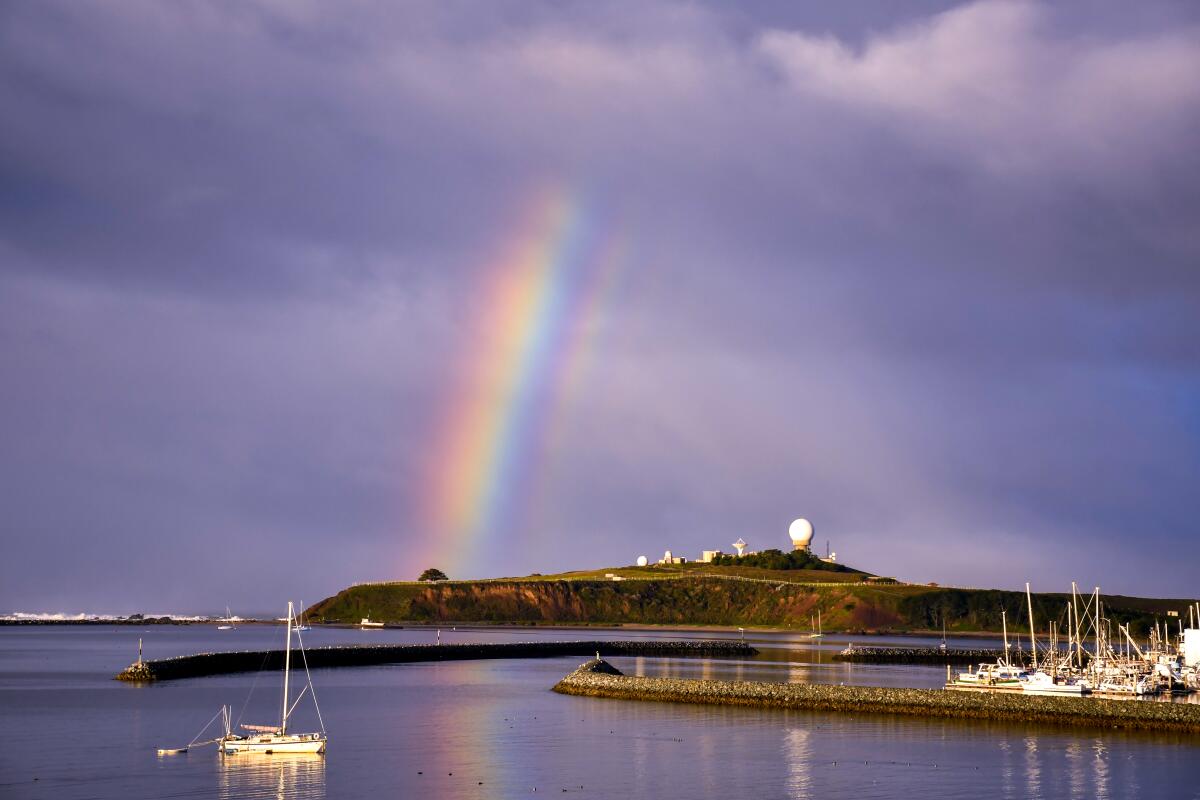
10 things to do in Half Moon Bay, an old-fashioned surf town that’s a whole Scotland mood
- Share via
Several weeks ago, I stood by my wife at the edge of a golf course in a bone-chilling wind, waiting for a bagpiper to appear as waves crashed on rocks below. All we lacked was a wee dram of single-malt whisky.
No, we weren’t in Scotland. We were visiting Half Moon Bay, about 380 miles north of Los Angeles, just 30 miles south of San Francisco.
The town feels much removed from both big cities, thanks to the green, rugged hills just inland and downtown’s modest scale and measured pace. Despite growing numbers of weekend visitors and remote workers from San Francisco and Silicon Valley, Half Moon Bay is a community with agricultural roots, a feed store on Main Street and a population that has remained at around 11,000 for the last 20 years.
Oh, and there’s the Ritz-Carlton, about 3 miles south of town, where a bagpiper is booked to play every sunset.
In other words, if you’re visiting, you’ll encounter a coast that feels like Scotland (especially in February) and a town reminiscent of Mayberry, the idyllic community with one traffic light from “The Andy Griffith Show.” Of course, no place is really that simple, but if you’re looking for a few days’ escape between L.A. and S.F., heading here is a good start.
Planning your weekend?
Stay up to date on the best things to do, see and eat in L.A.
If you don’t begin at the water’s edge, you’ll probably head straight for Main Street, which we did the next morning. There, within 100 steps of Half Moon Bay Feed & Fuel (founded in 1911), you’ll find a couple of art galleries, a gourmet olive oil retailer, the Barterra Winery tasting room and the beloved Garden Deli Cafe, where locals line up before the 10 a.m. opening time to get fresh bread and sandwiches.
A block farther south, in Mac Dutra Park at Main and Kelly Avenue, we found a great heap of flowers, along with condolence notes in English, Chinese and Spanish — the aftermath of the worst crime Half Moon Bay has suffered in years.
In late January, a farmworker — apparently angry over being bullied and billed $100 for damaging a fork lift — allegedly shot and killed seven people at two mushroom farms. He later pleaded not guilty and a trial is pending. The deaths prompted intense discussion about the proliferation of mass shootings throughout the U.S. and the hardships faced by agricultural workers in a community where two-bedroom apartments rent for $3,000 and the median home value has risen to $1.26 million.
After the deaths, investigators found that California Terra Garden, one of the shooting locations, had housed about 27 workers and family members in grim, unpermitted conditions. California Terra Garden has vowed to build new housing with proper permits, but substandard farmworker housing remains a statewide problem, now worsened by the winter’s flooding.
We spent a quiet moment in the park with the flowers and notes.
Later, we joined the many walkers on the 7.5-mile Half Moon Bay Coastside Trail, watching surfers work waves and thinking about the West Coast’s most famous big-wave surf break, Mavericks, an offshore phenomenon near Pillar Point that depends on fluctuating tidal conditions and is invisible from the coast highway.
Just getting to Mavericks Beach is tricky (read on for more about that), but when conditions are right, surfers paddle half a mile beyond that beach to catch waves that can reach 60 feet in height. As just about everyone who paddles out can tell you, one of those waves killed celebrated surfer Mark Foo in 1994, and the break’s menacing power has inspired documentaries, including Stacy Peralta’s “Riding Giants,” and books such as Mark Kreidler’s “The Voodoo Wave.”
Even if you never get your feet wet, it’s mesmerizing to stand by the jetty just south of Pillar Point Harbor and watch the swells at Surfers Beach surge, crest and crash.
After that, load up on seafood at Sam’s Chowder House, which has a dining room and big deck overlooking the waves. Your dietitian might not recommend the prawns stuffed with crab and wrapped in bacon at Sam’s, but I do. It’s a flavor riot of the finest kind.
Tourism heats up here in spring and summer, and traffic can get tough on weekends. That’s also true in fall, when Half Moon Bay’s Art & Pumpkin Festival culminates with a pumpkin weigh-off.
Since our visit, storms have felled trees and caused other damage in the area, briefly closing California 92, perhaps the busiest route into and out of town. That route is open again. But in weeks to come, it makes sense to check the Caltrans website for highway conditions before driving any place in Santa Cruz or San Mateo counties.
Half Moon Bay may be a small town, and a slow one (in the best possible sense). But it also punches above its weight — there’s more to explore (and eat) than in most destinations this size. In fact, we’ve been noodling around itinerary ideas for the next trip. Sunday afternoon jazz at the Bach Dancing & Dynamite Society? A pint at Cameron’s Pub? We’ll be back before long.
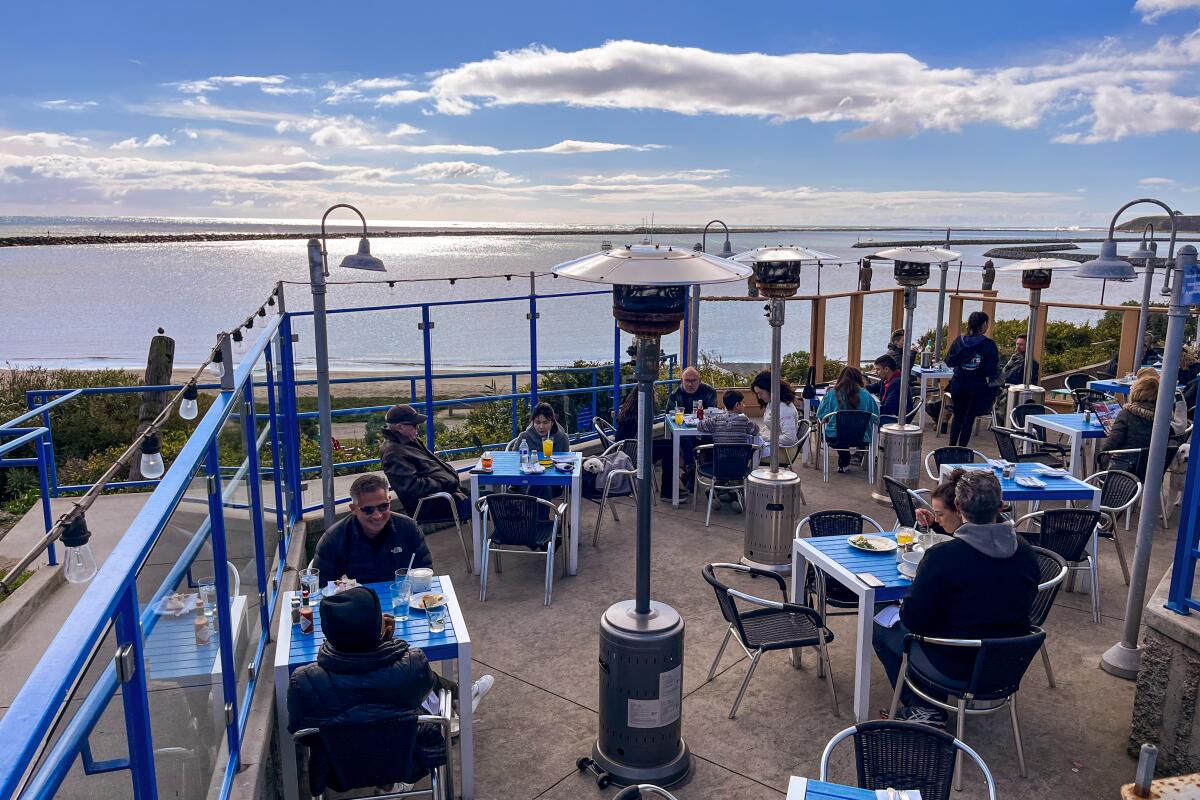
Arrive hungry at Sam's Chowder House
The restaurant, which opened in 2006, has SamCams, so you can check the weather on its patio before you leave home. Catch live music on Friday and Saturday nights from local acts performing jazz, blues, folk and acoustic rock.
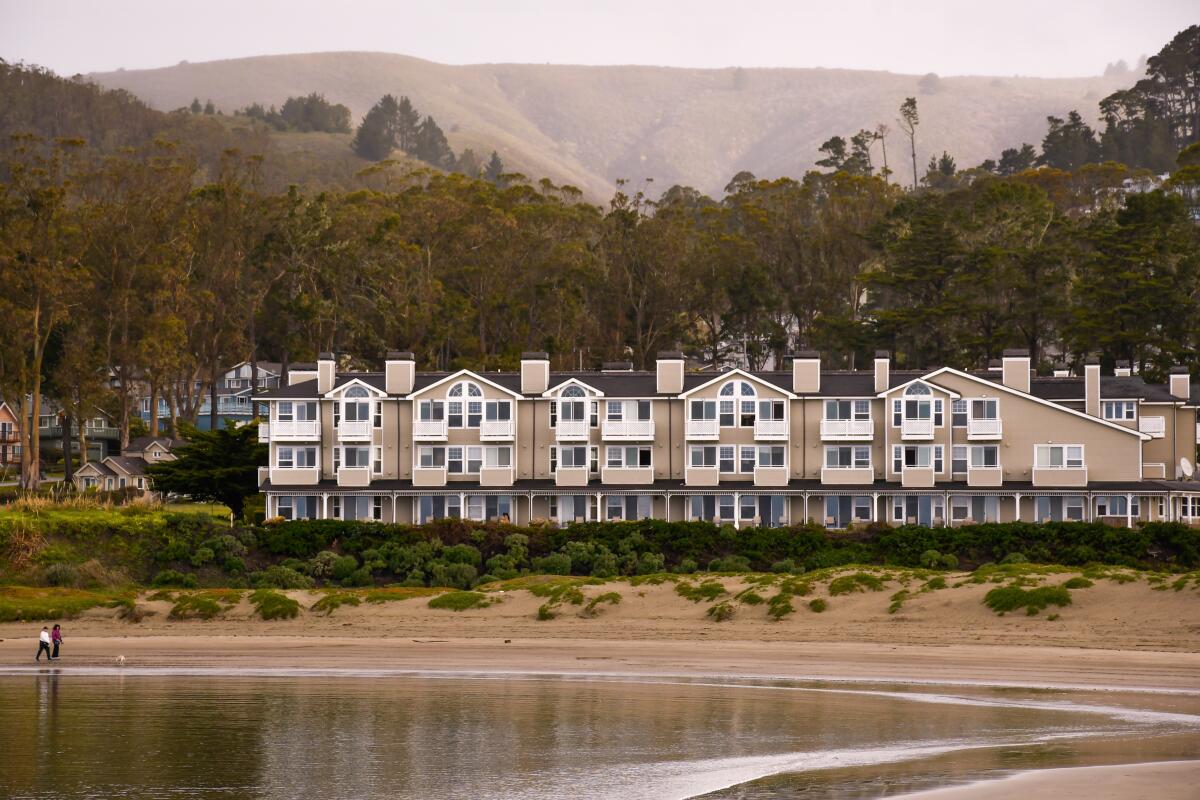
Check in at the Beach House Hotel
The rooms also have fireplaces — welcome on chilly nights — and come with continental breakfast in the lobby. Outside, the hotel has a pool, a Jacuzzi and a gated path connecting to the 11.5-mile Coastal Trail that includes Half Moon Bay and neighboring communities. (The Beach House has a sibling property in Hermosa Beach, also called the Beach House, also three stories, with similar room design.)
A little history: In 1996, when this hotel was being built, someone leveled it in an arson-caused fire — which drew applause from some inland neighbors who were losing some of their ocean view because of it. The developer rebuilt, and life goes on. Room rates in April and May typically start at $295 on weekdays, $335 on weekends.

Grab tacos at Tres Amigos
A lot of surfers go for the breakfast burritos — plenty of calories in a snug package. The kitchen also offers Mexican Coke, Jarritos and beer to drink and churros for dessert. It’s $3.64 for a taco. I paid $5.15 for a zesty, filling ceviche tostada with red snapper.
The original amigos came to California from the Mexican state of Jalisco, where tacos de lengua (beef tongue) are a big thing. So yes, they’re on the menu along with chicken, pork and pork sausage tacos. The tortilla options? Flour, spinach, chipotle, wheat and tomato.
Tip: The restaurant charges 4% for credit card transactions, so bring cash.
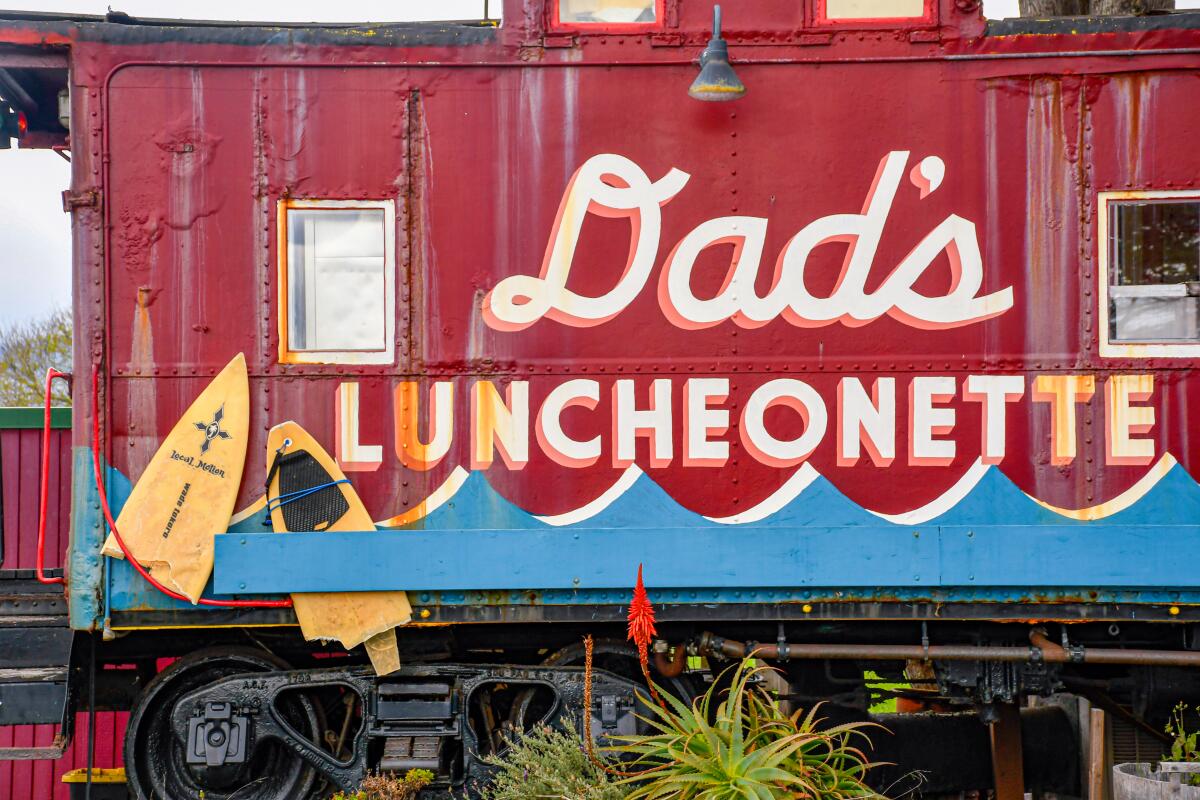
Dad's Luncheonette
As the setting suggests, Dad’s is an eccentric operation. There’s often a line. Some weeks, without warning, there are rose pistachio lime cookies. Last Father’s Day, every dad was offered a free beer. Sometimes the kitchen runs out of ingredients and closes early. But the restaurant is usually open from 11 a.m. to 4 p.m. Thursday through Sunday, except from mid-December through mid-January, when the owners close it for “hibernation.”
The backstory is that chef and co-owner Scott Clark used to work in fancy restaurant kitchens (including San Francisco’s Saison, which has two Michelin stars), but chucked that after becoming, yes, a dad. He and his partner, Alexis Liu, opened Dad’s in 2017.
We got our lunch there on a cold day just after the reopening, when the 18-seat patio was packed. There’s no dining room. So we ate in our car — and, still, the flavors and textures were so good that the car went quiet.
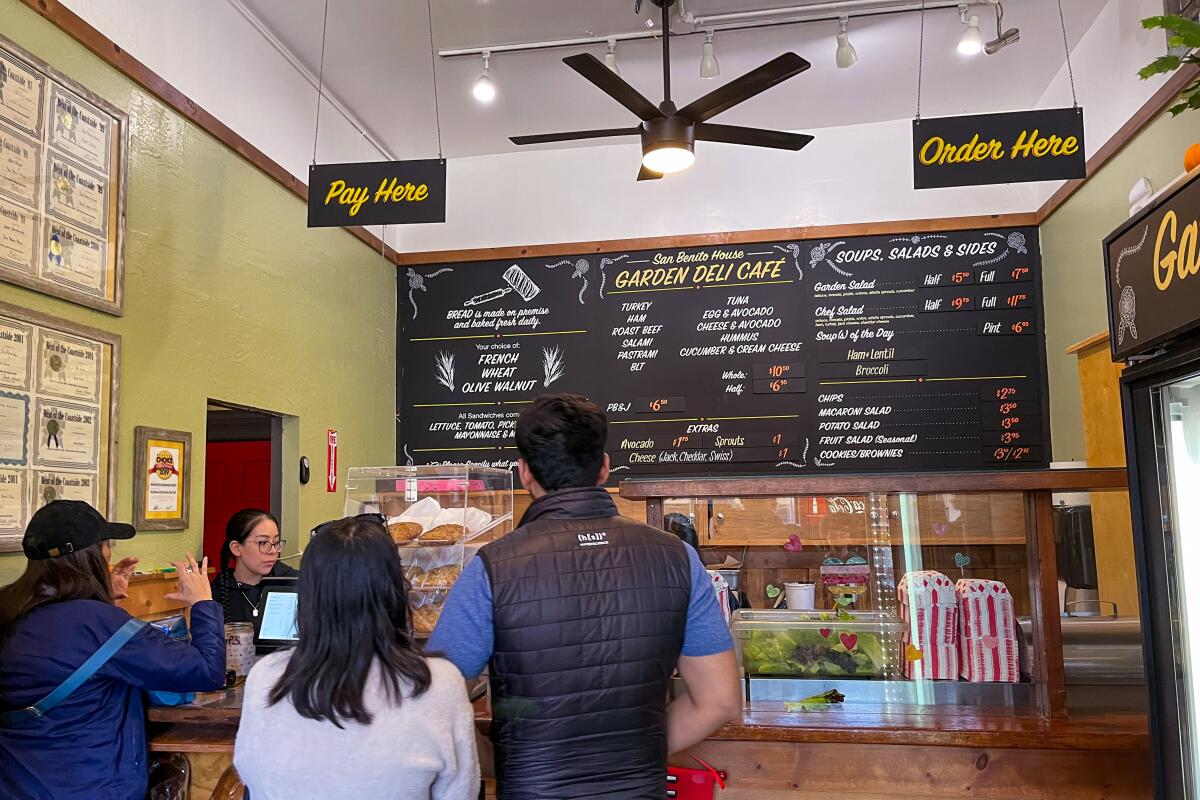
Get bread at the Garden Deli Cafe at San Benito House
The café is part of the San Benito House complex, which also includes the ground floor Cantina on the corner. Lots of burgers, tacos, burritos, cerveza and tequila there.
The San Benito House, built in 1905, also includes a six-room inn, but that was damaged in a 2021 fire and has not yet reopened. (The damage is just about invisible from the street.)
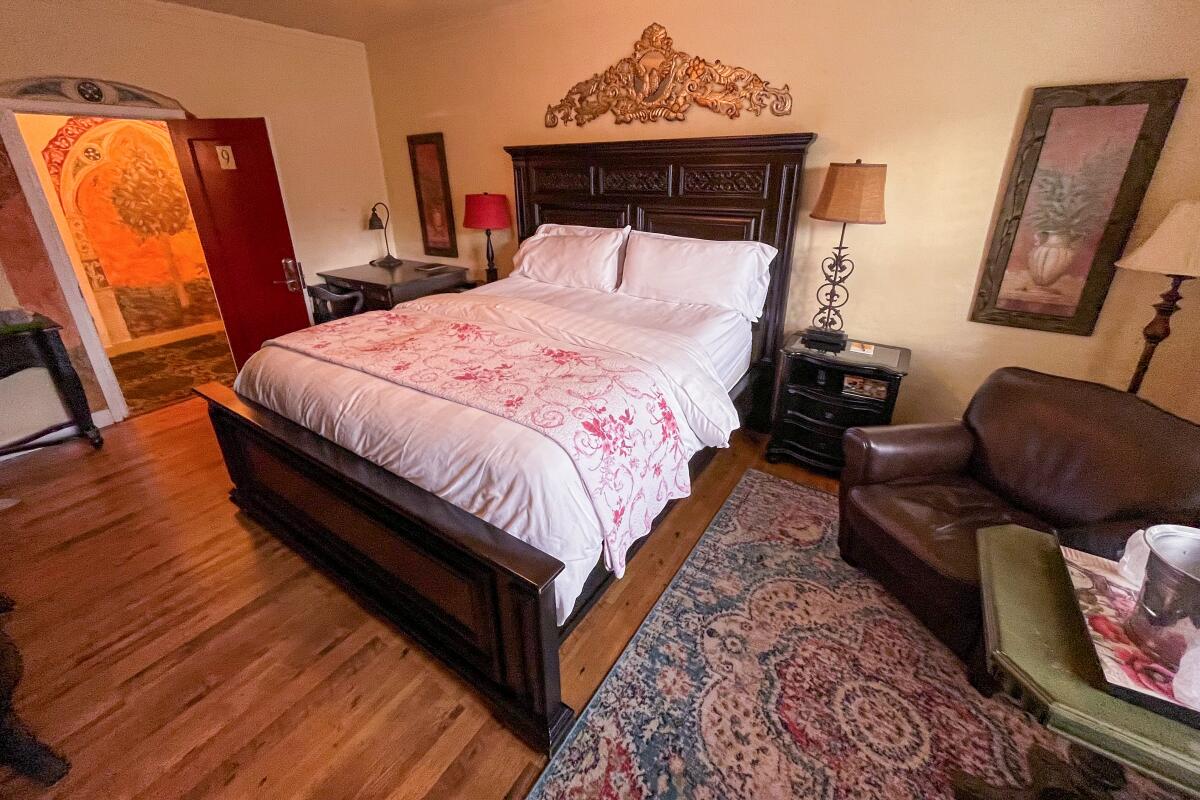
Sleep at the Half Moon Bay Inn
The interiors are full of flourishes you’d never find at a Hilton or a Hyatt, from the jewel-box kitchens in two of the suites to the fanciful stencils and murals on the walls, which made me think of a European pensione. On its ground floor, the inn houses the restaurant It’s Italia (since 2008), open Tuesday-Sunday for dinner and Sunday brunch.
Rates start at $185 on weekdays, $225 on weekends. Parking: free. Dogs? Allowed (for $50 per stay).
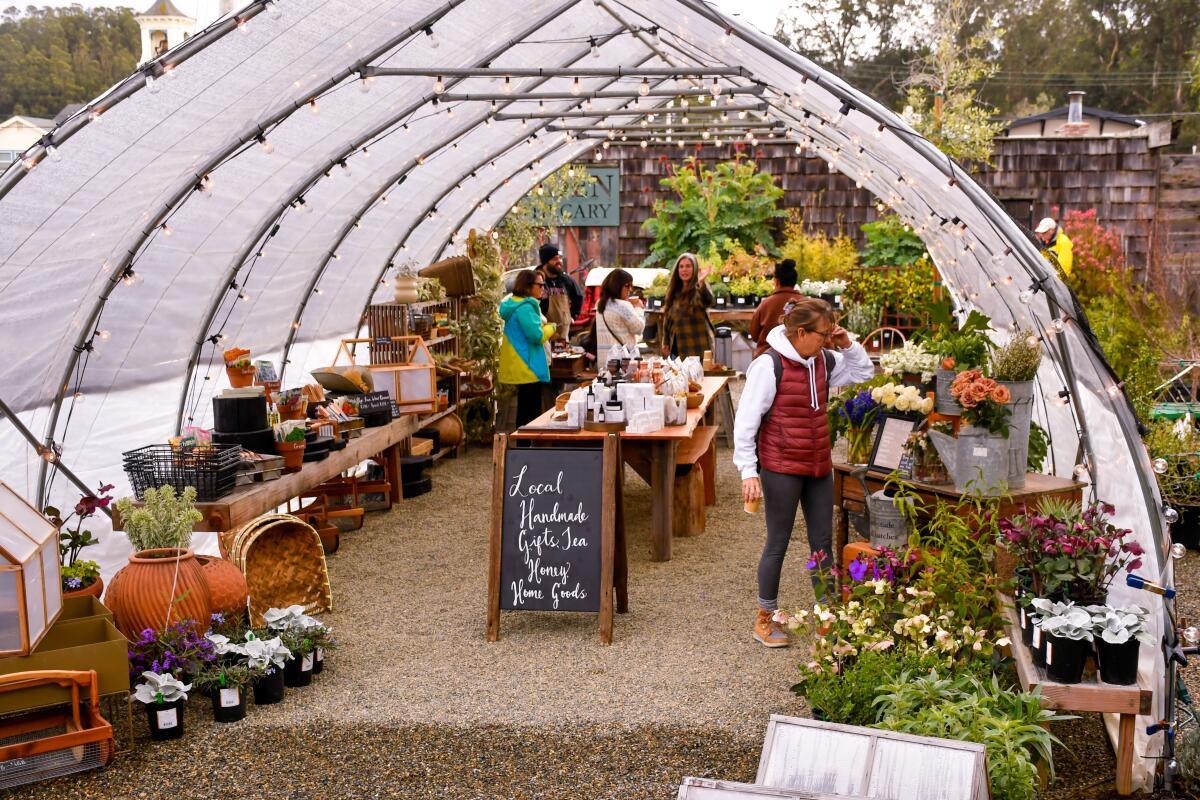
Explore Main Street
Main Street is also where the annual Art & Pumpkin Festival takes place, and this is no small thing. Last year’s winner, Travis Gienger, drove 35 hours from Anoka, Minn., to deliver his prize pumpkin, which weighed in at 2,560 pounds — the largest in recorded North American pumpkin history. (The next fest: Oct. 14-15.)
As we strolled, there were some standouts: My wife and I lingered at Garden Apothecary (marked on this map; features garden products, herbal skincare and herbs and teas), Earth Impact (plants, gifts and cushions impersonating cactuses), LuzLuna Imports (fair-trade goods from Guatemala, Peru and beyond) and Coastside Books (where I found a book on Willie Mays I’d never seen before).
You should make at least one detour, a block inland to 505 Johnston St., where the Half Moon Bay Coastside History Museum has taken over the old town jail, built in 1919 with two cells. What is it that draws us to jails that are retired from duty? How many years have to pass before crime and punishment become quaint? I don’t know the answers, but this snug little hoosegow, about the size of a candy shop or modest Carnegie Library, would surely do well on Airbnb if it weren’t otherwise employed. (The museum, open 11 a.m. to 3 p.m. on weekends, is now expanding into the barn/garage behind the jail as well.)
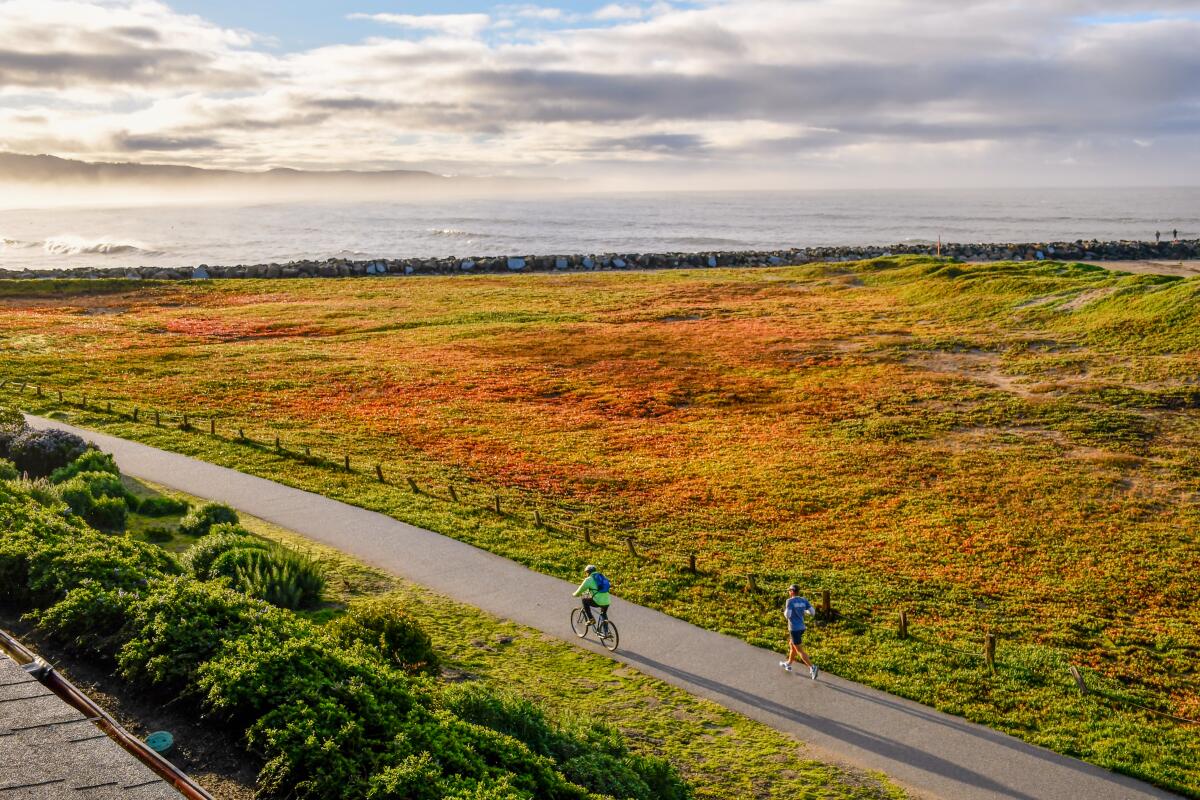
Jog or pedal the Half Moon Bay Coastside Trail
Also, it’s wonderfully flat. The trail’s northern end is the Pillar Point Launch Ramp at the end of Pillar Point Harbor Boulevard in Pillar Point. Its southern end is Miramontes Point Road, just south of the Ritz-Carlton Resort Half Moon Bay. If hunger (or thirst) strikes along the popular El Granada stretch, you can step right into Sam’s Chowder House.
Along the route you’ll find four beaches — Francis, Venice, Dunes and Roosevelt, each with a parking lot. If you’re staying at the Beach House or Cypress Inn, you can step right onto the trail.
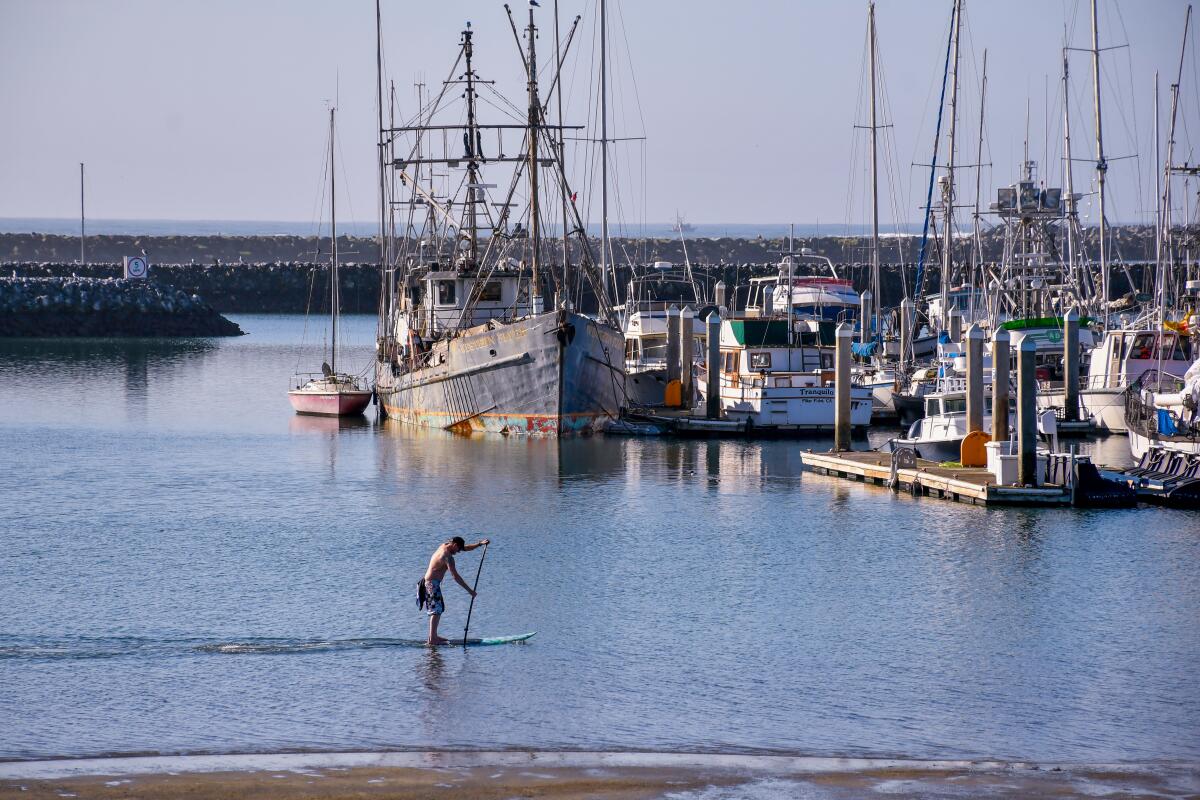
Scope out boats, seafood and surfers at Pillar Point Harbor
The harbor also includes kayak and paddleboard rentals, sportfishing and whale-watching trips and several bars and restaurants. There’s a notable surf shop, Mavericks Surf Co., which has long been associated with the monster waves that materialize now and then off Pillar Point, drawing big-wave surfers from around the world. Jeff Clark, the owner of the shop and a globally known big-wave surfer, grew up in the area and quietly surfed Mavericks on his own for years before it was discovered and embraced by the wider surfing community.
Some visitors are eager to see Mavericks Beach, where big-wave surfers begin their long paddle out, but getting there by land is tricky, because much of the area is controlled by the Pillar Point Air Force Station. Head through the community of Princeton-by-the-Sea (next to Pillar Point Harbor and north of Half Moon Bay) to the parking lot near the end of West Point Drive. Then walk the dirt trail, as is explained here.
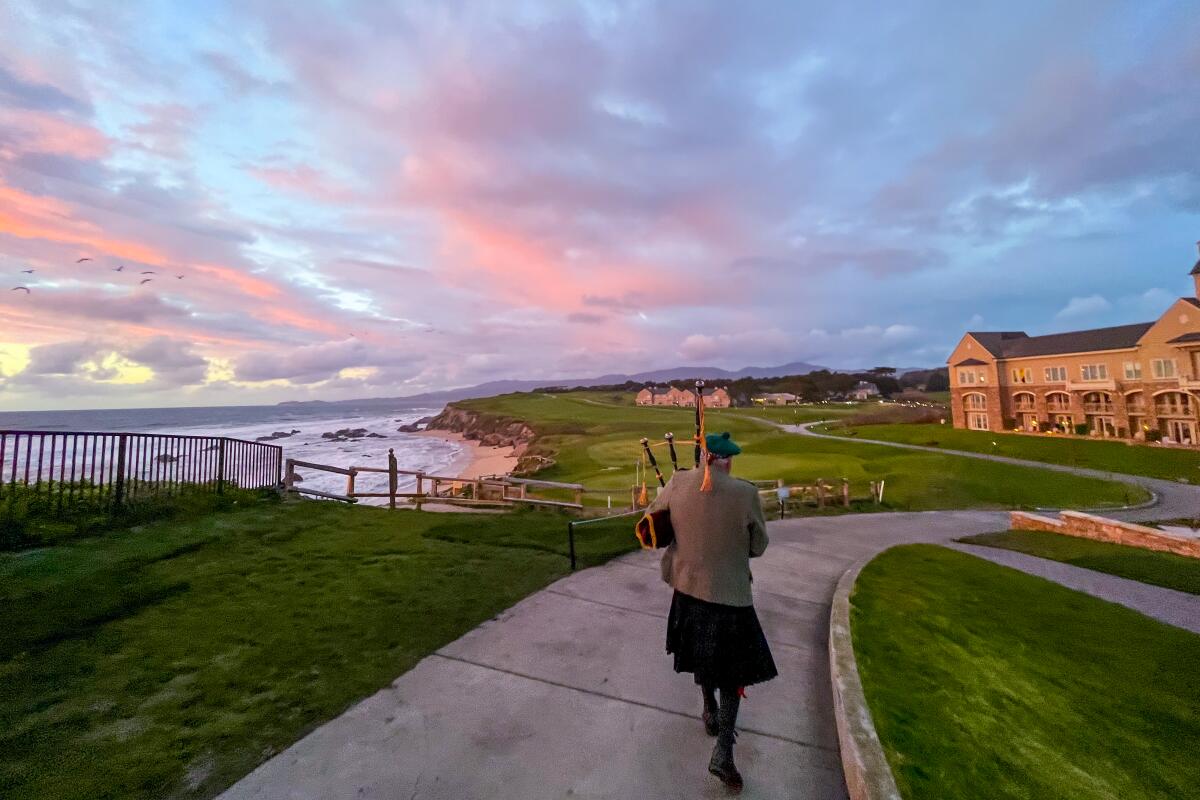
Listen for bagpipes at the Ritz-Carlton
That’s when a bagpiper shows up nightly to serenade whoever is on hand outside. You see the ocean, the bluffs, the seaside golf course — it’s memorable.
And it can be fleeting. On the cold, windy night we were there, I don’t think the bagpiper ever broke stride. Within a few minutes, he was gone. But before he fled, that sound and scenery brought Scotland to life, like the ghostly village in “Brigadoon.” (Did lodging in “Brigadoon” cost $930 per night and up?)
The resort, built in 2001, includes two golf courses, two restaurants, 261 guest rooms and suites, three fire pits overlooking the ocean, six tennis courts and several condo-style lodgings in a separate building. Several ground-floor units have private fire pits. We ordered a round of beer, wine and sodas at the bar and took them out to the common-area fire pits just in time to catch the bagpiper.
Next time, if it’s warmer, maybe we’ll stroll for a bit on the California Coastal Trail, a segment of which wraps around the resort.
Pro tip on parking: Day parking rates at the hotel are $30 on weekdays, $50 on weekends. But there is a small, free California Coastal Access parking lot a quarter-mile south of the hotel on Miramontes Point Road near South Maple Avenue. There are also 25 free coastal access parking spots in the hotel garage.
Sign up for This Evening's Big Stories
Catch up on the day with the 7 biggest L.A. Times stories in your inbox every weekday evening.
You may occasionally receive promotional content from the Los Angeles Times.



